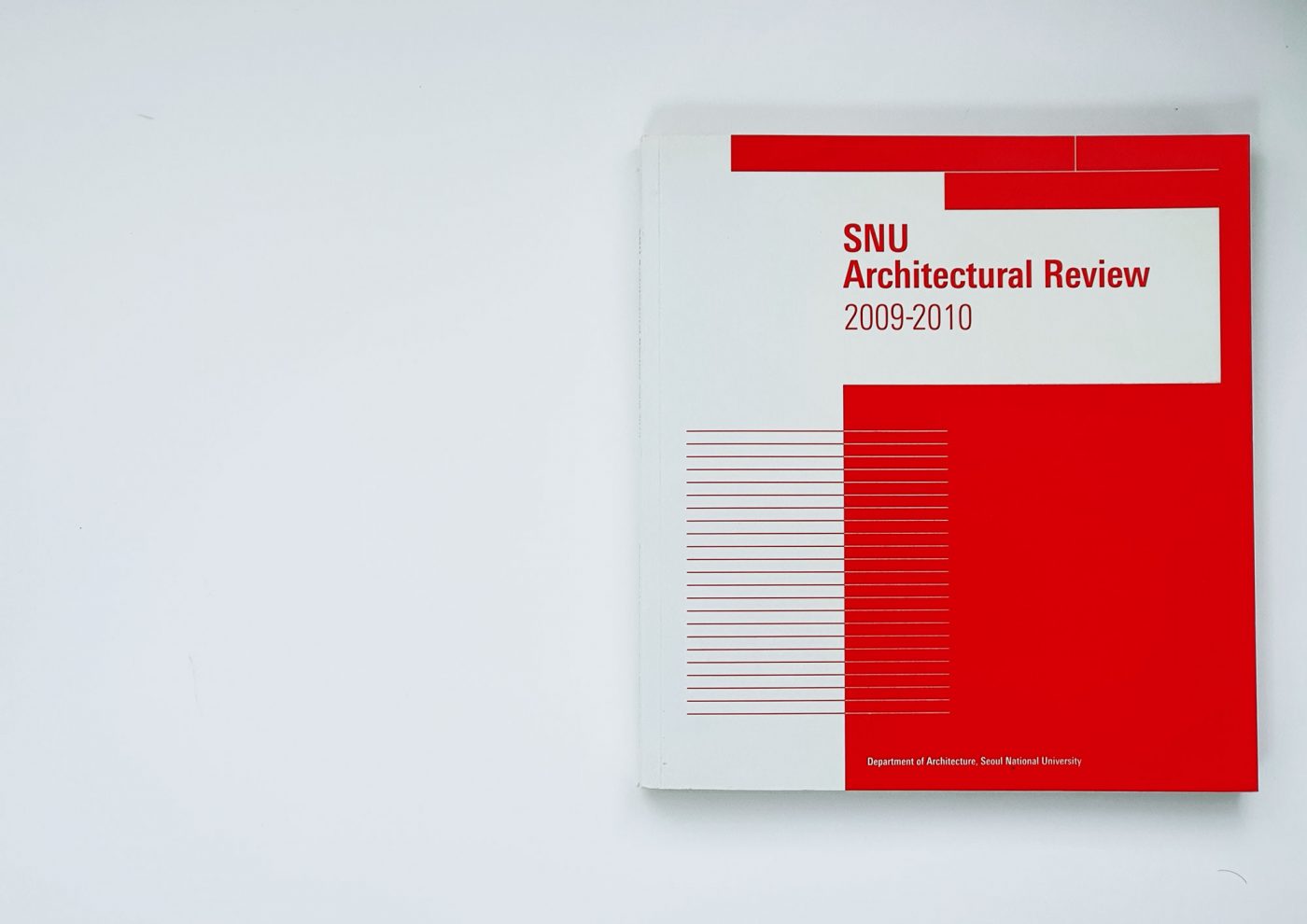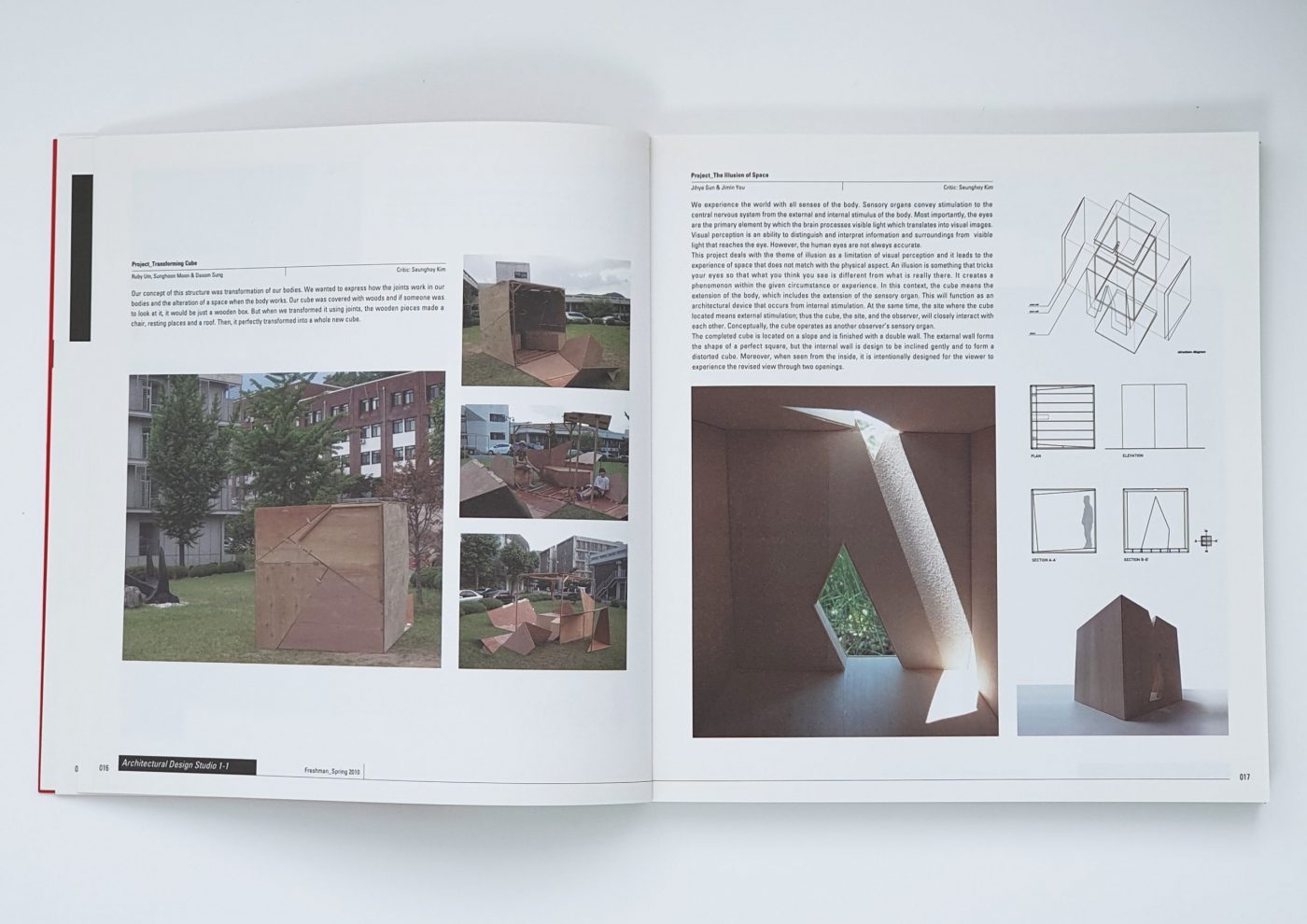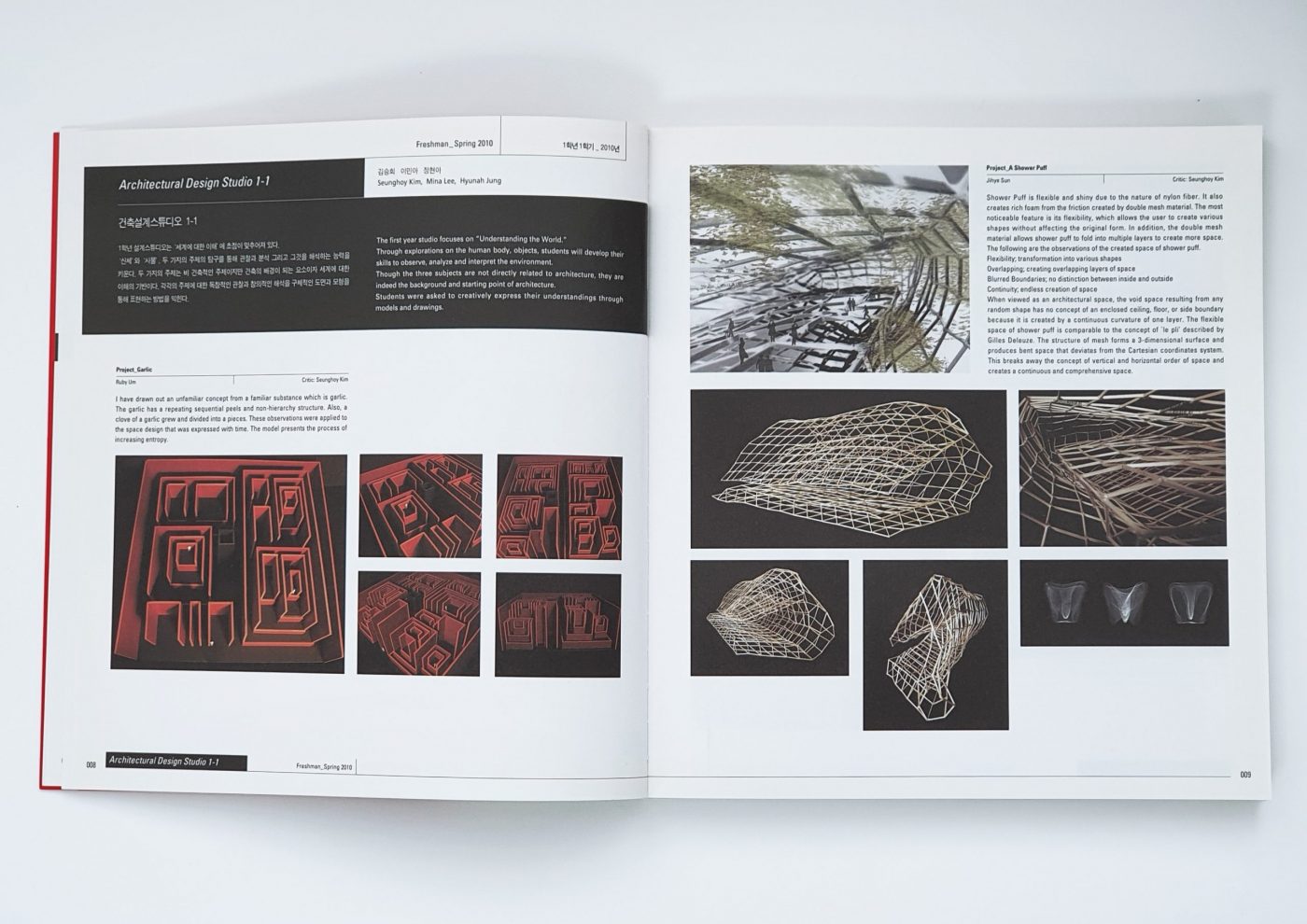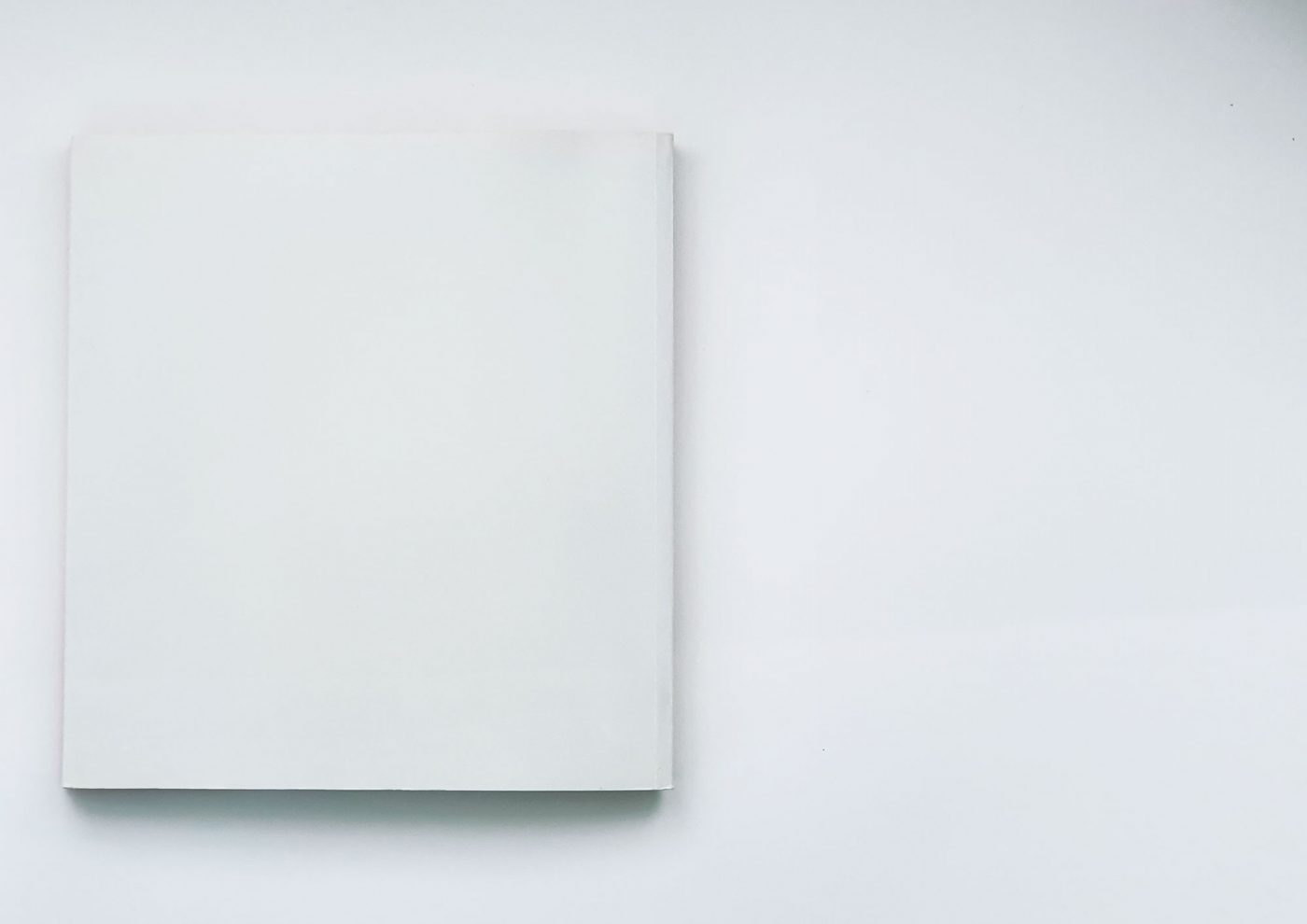SNU Architectural Review
2009 – 2010
2010, 1-1
건축설계스튜디오 1-1
신체, 사물, 텍스트
김승회, 이민아, 정현아
엄루비, 선지혜, 노동완, 문성훈, 고경훈, 이현민, 최태환, 제원모, 이민홍, 성다솜, 유지민, 김여솔, 박혜상, 주종웅, 허영현, 박정현, 임하린
1학년 설계스튜디오는 '세계에 대한 이해'에 초점이 맞추어져 있다. '신체' 와 '사물', '텍스트들' 이라는 세가지의 주제의 탐구를 통해 관찰과 분석 그리고 그것을 해석하는 능력을 키운다. 세가지의 주제는 비건축적인 주제이지만 건축의 배경이 되는 요소이자 세계에 대한 이해의 기반이다. 각각의 주제에 대한 독창적인 관찰과 창의적인 해석을 구체적인 도면과 모형을 통해 표현하는 방법을 익힌다.
The theme of this studio iws 'how to read the surronding and world'. Throught the researching on the 3 kinds of texts; things and place, we are developing abilitiies of observation, analysis and interpretation. Even though these 3 texts are not architectural themes, these are the background of architecture and the foundation of understanding the world. We are also learning how to express result of observation and unique analysis as a specific plan and model.
2010, 2-1
건축설계스튜디오 2-1
Learn the process of design
최두남, 피터페레토, 서을호
경연성, 조예린, 심수진, 황보성, 문주희, 김상, 현은수, 박시은, 소유정, 박채니 Chanie Park, 박성경, 송철호, 이예슬, 배의진, 김태환
이 과목은 공간을 설계함에 있어 주어진 환경 및 대지를 면밀히 관찰, 분석하고 공간구성의 틀을 만드는 기본적인 건축개념들의 학습을 통하여 사용자의 기능에 대한 요구를 만족시키며 개념이 내재된 조형을 이용하여 건출을 구축하는 방법을 습득하는 것을 목표로 한다. 건물을 포함한 전체 대지를 설계함으로써 대지분석에 대한 중요성을 강조하고 설계 진행과정에서 설계의도를 효율적으로 표현할 수 있는 설득력과 시각적 표현기법의 숙달을 꾀하며 자료 분석을 통한 사용자, 기능 및 프로그램에 대한 철저한 이해가 이루어질 수 있도록 한다.
The objective of this course is to help students to learn the process of design by encouraging them to get familiarized with the basic architectural concepts. Students are asked to carefully analyze the given context and the site, which are important part of design considerations, in the process of establishing architectural concepts that would reflect architect's aesthetic vision. Emphasis will be given on having students engaged in total design process in which students would learn to address such issues as site planning, program analysis and building design.
2009, 2-2
건축설계스튜디오 2-2
building materials and structural systems.
최두남, 심우갑, 피터 페레토
함영걸, 정소라, 고승훈, 공석현, 박지형, 박승호, 박은정, 이명기, 이상욱, 황민, 박용준
이 과목은 설계를 진행함에 있어 공간 창출과 완성에 필요한 기술적인 측면에 대한 비중 있는 탐구를 통하여 재료에 대한 이해와 물성에 대한 감각을 높이며 건물이 구축되어지는 시공과정과 건물 구조 시스템에 대한 포괄적인 이해와 탐구가 이루어지도록 한다. 적절한 재료선택에 필요한 기본적인 건축적, 기술적인 지식을 바탕으로 다양한 구조시스템의 가능성 및 잠재성에 대한 개괄적인 이해가 이루어질 수 있도록 한다.
The objective of this course is to emphasize the importance of the technical aspect of architectural design by having students pay attention to building materials and structural systems. Students will have opportunities not only to examine the potential design possibilities of various structural systems but also to develop tectonic awareness of building materials.
2010, 3-1
건축설계스튜디오 3-1
다양한 건물관 관계 짓기/건물군과 도시 컨텍스트 사이 관계짓기
김현철, 장용순, 이종수
박은정, 이상욱, 황민, 박지형, 서유정, 박성호, 이병준, 이명기, 최한솔, 김자연, 공석현, 최준호, 권상진, 이가현
3학년 설계스튜디오는 단순 사용자 건물 혹은 단일개체 설계에서 다중 사용자/ 다중개체 설계를 나아감을 목표로 한다. 이를 위하여는 구조는 단일 완결 구조에서 반복구조로, 중규모의 다양한 사용자가 이용하는 기능을 다룬다. 이 과정에서는 다양한 건물관 관계 짓기/건물군과 도시 컨텍스트 사이 관계짓기로 이루어지는 배치계획과 특정한 형태를 고안하는 형태계획이 중점적으로 다루어진다. 기능상으로는 특수한 건축물이 갖추어야 할 프로그램에 대해 숙지할 기회를 제공한다. 이를 위하여 3개의 스튜디오에서는 서로 다른 3개의 프로그램을 상이한 대지조건에 설계하도록 하여 학생들에게 다양한 프로그램을 선택할 수 있는 기회를 제공한다.
Architectural design studio 3-1 has the goal of processing from a simple building for individual user to a complex building for various users. In the assignment, site planning and shape planning will be the main work derived from making relationship among different buildings, building complex and the urban context. Students will have the opportunity for understanding program of specialized buildings. For this, students can select their own program from 3 different projects in 2 groups.
2009, 3-2
건축설계스튜디오 3-2
건축가의 작품구성의도, 작업전략, 공간 및 형태구성 방식
김현철, 장용순, 임재용
이성환, 정민선, 허지은, 문현식, 이진경, 진민주, 변희영, 이창빈, 유균형
건축설계의 기반을 이루는 총체적 건축계획에 대한 전문적 연구를 목표로 한다. 이론계획학의 한계에 머물지 않고 건축가들이 설계할 때 실제로 부딪쳐 온 작품구성의도, 작업전략, 공간 및 형태구성 방식을 광범위하게 분석함으로써 건축작품에 대한 이해를 넓힘과 동시에 그 결과를 자기 건축에 도입함으로써 독창적인 건축언어를 수립할 수 있는 기초와 근거를 연구한다.
This course aims to study professionally on comprehensive planning of architecture which forms the foundation of architectural planning, to broaden the width of understanding of architectural works through analyzing the ways of forming space and its shape beyond the limit of theoretical planning, and at the same time studies the groundwork to set up students' own creative language of architecture by introducing the studied results into students' works.
2010, 4-1
건축설계스튜디오 4-1
Fashion Hive
김진균, 피터 페레토, 김성우
김대정, 강은지, 이정한, 이문영, 문주호, 표하림, 김지우, 이창빈, 변희영, 허지은, 문현식, 김가영, 박승진, 유균형, 백수연
이번 스튜디오의 목적은 패션을 형상화 하는 모든 인식들을 바탕으로 Fashion Hive를 디자인 하는 것이다. 옷의 생산과정에서부터 전시되고 팔려지기까지 모든 과정을 조사하여 학생 스스로의 프로그램으로 제안할 것을 장려한다. 예를 들어, 패션학교, 신진 디자이너의 작업실, 전시장, 패션쇼, 옷 제작 작업실, 신진 디자이너들의 의상 솝 등의 프로그램을 생각할 수 있다. 학생들이 백지상태에서 프로젝트를 시작하기 보다, 주어진 대지를 교정하고, 연결하고, 초점을 맞추며 개간하는 과정이 요구된다.
The objective of the studio is to create a Fashion Hive, a complex which engages with the notion of fashion in all its forms. From production and manufacturing to display and retail. Students will be asked to investigate the motion of a fashion hive, and encouraged to develop their own program to include: Fashion Design School/ Working studios for young designers/ exhibition spaces/ fashion shows and catwalks/ Clothes fabrication workshops/ Retail spaces for young designers/ Etc... Rather than start with a tabula rasa condition all students are required to develop projects which, address, reclaim and surgically connect with the existing fabric of the above mentioned site.
2009, 4-2
건축설계스튜디오 4-2
중심상업지 통합개발 계획
김광현, 김태만, 함인선
강민지, 김예리, 소정은, 정유리, 이승환, 심현재, 하숙경, 위의정, 이준희
중심상업지 통합개발 계획 건축설계는 점차 도시의 영역으로 확대되고 있다. 그리고 건축설계를 가능하게 하는 각종 규제와 지침, 요구조건이 예전과는 크게 달라져 이제는 도시의 영역을 구축하는 작업으로 변화하고 있다. 따라서 도시 안의 건축설계는 도시설계를 구체화하는 일이며, 실제의 사업 목표와 매우 밀접한 관계를 가지고 있다. 도시를 구성하는 대단지를 구성하는 데 참여하는 발주자의 요구와 시행의 현실적인 가능성, 새로이 조성되는 주거지에 상업적 활기를 불어넣기 위한 대규모 건축 프로젝트를 연습함으로써, 공공발주와 그에 따른 각종의 사업적 요구사항을 충족하기를 요구하는 오늘날의 개발사업을 이해하고, 건축가가 이러한 프로젝트에서 어떤 창의력과 설득력으로 도시공간을 새롭게 창조하는 건축물을 만들어낼 수 있는가를 탐구하도록 한다. 이를 위해 최근 대규모 건축사사무소에서 참가한 실제 프로젝트를 대상으로 PF컨설팅과 발주자측의 실제 상황을 들으며 앞으로 만나게 될 도시건축 설계의 핵심적 내용을 공부한다. 또한 이에 도시 주변부에 대한 면밀한 검토와 전략시설계획의 제안과 배치, 단지 전체를 활성화하는 컨텐츠 개발과 디자인을 함께 고려한다.
Design Objective: An integration development of the central retail district is expanding towards the city. Additionally, the architectural restrictions and guidelines are changing to expand the territory of a city. Therefore, architectural design in a city is giving a shape to the city and has a close relationship to the architectural business objectives. To understand today's development project and to research how an architect produces a creative architecture is the objective of this design studio. Students would be practicing a vast size project that makes a residential area more alive adding a commercial retail function, with understanding of a clien's request which has a possibility to carry on. The practical knowledge between the client and PF consultant would be given to students which the knowledge is critical to the urban architectural design. A thorough review, strategic facility plan, and contents development should be considered along the design development.
2010, 3-1
건축재료계획
건축공간과 재료의 관계
김승회
송혜진, 신재희, 서보경, 고유림, 이가현, 박은정, 김강현, 박지형, 남호성, 박유진, 최정미, 이평희, 최한솔, 이명기, 황민, 이상욱, 이병준, 박승호, 김찬우, Batsukh Tseemyagmar, 손영일, 백도현
건축가에게 있어서 재료는 건축의 요소로 이해되는 것이 아니라 건축 그 자체이다. 그러므로 재료는 설계의 마지막 단계에서 결정되는 것이 아니라 첫 단계에서부터 대지와 프로그램과 함께 총체적으로 다루어져야 한다. 재료계획의 수업을 통해서 재료의 성질과 그 사용 방식에 대해 이해한다. 그 이해를 바탕으로 재료와 관련된 건축디테일을 탐구하고 실제 건축공간과 재료의 관계를 살퍼본다. 한편으로 재료의 본질과 개념에 대한 숙고를 바탕으로 새로운 물질성에 대한 탐구가 이루어진다. 목재와 유리, 금속등 구체적은 재료로 오브제를 만드는 과정을 통해 재료와 물질에 대한 속성과 물성에 대한 독창적인 해석과 창의적인 표현을 실험한다. 이러한 재료에 대한 이해를 바탕으로 그것이 실제로 어떻게 건축물을 통해 구현되는지 구체적인 사례를 통해 탐색하고 재료에 관한 총체적인 이해와 전망을 습득한다.
For the architect, the material is not considered as the element of architecture; the material is architecture itself. So, the material has not to be decided at the last process, but handled at the beginning with site and program. Through this course, it would be studied that character of material and its usage, architectural detail that material needs, researching of new materiality. Understand the nature of material and usage of it. To aware of it, explore architectural details related to the material. Consider the relationship between architectural space in real scale and the materials. At the same time, research on physical make-up as new stood on the consideration about an essence and concepts of material. By making an object with specific materials like wood, glass, metal etc. experiment unique interpretation and creative presentation. Search the case how architecture is embodied, by understanding material, and learn the prospect and general understanding.
2010, 3-1
공학설계 1
드로잉
이병연, 임상진
홍민기, 고태우, 손진호, 김수민, 박정환, 전상윤
건축공학을 전공함에 있어서 기본이 되는 드로잉과 기초적인 설계를 통하여 도면작성요령과 도면을 이해하는 방법을 익힌다. 도면은 건축물로 표현하는 방법이며 설계. 구조, 시공분야에 종사하는 사람들의 의사소통의 매개체로서 매우 중요하다. 도면을 읽고 머릿속에 3차원의 그림을 그릴 수 있는 능력이 필요하다. 이를 위하여서는 먼저 측정과 스케일에 대한 개념을 가지고 간단한 도면을 작성하며 설계를 통하여 이를 체득하게 한다.
Through drawings and basic design based on the architectural engineering, we learn how to draw and comprehend the blueprint (plan). The blueprint (plan) is very important since it is a way to express a building and a medium among people working in many other positions ? design, structure, construction, and etc. We required the ability to read a blueprint (plan) and to come across one Øs mind the spatial view. To achieve this ability, we learn to design and draw the blueprint (plan), holding the concept of dimension or scale.
2009, 3-2
공학설계 2
total design space
임상진, 김종천
신민규, 김은진, 김상우, 정기혁, 김민규, 최윤정, 백승룡, Mac Jun
1학기 건축설계을 통하여 도학과 도면읽기, 실측, 모형제작, 주택설계과정을 살펴 보았다. 2학기에는 건축물이 생성되는 과정에서 요구되는 프로그램 및 건축의 방향에 대한 기본적 기획을 포함하여 기본 설계에 이르는 과정을 직접 진행하고 이를 프로젠테이션 한다. 이를 위하여 평소 도시공간 (보다 확장된 의미에서의 건축공간-건축물 뿐만이 아닌 모든 시설물들)에 대한 "total design space"라는 관점에서 문제의식에서 이번 민간, 공공의 범위를 포괄하여 출발하여, 스스로 부여한 조건에 부합하는 시설물의 기능, 세부적인 프로그램의 아이디어가 발전되어 이를 visual media로 의도와 예상되는 결과물을 표현할 수 있도록 한다. 진행방법은 대지 및 프로그램 선정으로 시작되는 "기획단계"에서부터 그 연장선상에서 각자의 "기본설계수행" 단계를 가지게 되며, 결국 이들이 합쳐지면 다양한 형식으로 존재하는 "사업제안서"의 기본 형식을 작성하며, 이를 완성된 프리젠테이션 형식으로 제시한다.
Reading plans and sections, actual measurement, making physical model and
process study of residential housing were the objectives of the first semester. Planning architectural programs, brief understanding, and design document study were the objectives of the second semester. Students were asked to express the consequences of raised questions from space in a city which, regards beyond the architectural space and buildings that includes all the facilities of a city. Founded qualified functions were developed and expressed through visual media. Students choose the site and find suitable programs which are the planning process. Then they propose their design document which results the 'Service Proposal'. Students present a presentation in order to submit their works.
2009
졸업설계
졸업설계
장유진, 김세학, 임지영, 조성현, 기세호, 유진희, 김수현, 이보름, 박유나, 김자연, 문성준, 이다미, 배현욱, 문주호, 이강형, Jungoo Lee, 이윤정, 김형주, 김태훈, 이순환, 이예지, 유재신, 최은희, 이현수, 김정권, 이길호, 양순락, 이천호, 유성희, 고규연, 조성준, 신주영, 최유정, 고아라, 김석영, 정재국, 한승은, 이재규, 임한상, 양두혁, 이범연
졸업설계는 자신의 건축적 사고를 독자적으로 발전시키고, 이를 현실의 조건 위에서 구체적으로 실현하기 위한 작업입니다. 이를 위해 수강지는 각자 현대도시를 분석하고그 현대도시가 우리의 일상생활에 어떤 경로를 거쳐 건축공간과 형태에 영향을 미치는지를 검토합니다. 그리고 도시의 일각에 서게 될 대지에 주목하면서 대지에 얽힌 다양한 사람의 흐름, 물리적인 문맥, 자연환경에 대한 고려를 어떻게 설정하고 있는지를 건축적 어휘를 사용하여 구체화하여야 합니다. 또한 자신이 설정한 프로그램을 논리적으로 해석하는 능력을 발전시켜 건축가라는 직업인으로서 앞으로 지속해야 할 자신의 가치를 발견하도록 합니다. 더욱이 졸업설계에서는 건축디자인의 기초요소만이 아니라, 구조와 설비 등 기본적인 엔지니어링의 조건도 아울러 생각하여 반영하여야 합니다.
The graduatioon exhibition is a task to develop students' architectural thoughts in their own way and to realize the thoughts specifically in actual conditions. Students analyze modern cities and investigate how those cities affect to architectural spaces and shapes through what channel in our daily life. Furthermore, students embody their consideration for human flow, physical context and natural environment attending sites as the tip of the city. Students should develop their ability to analyze logically the program set up by themselves. That is the way to find their values that should be kept up as a professional architecture. The graduation exhibition reflects basic engineering conditions - structures, facilities and so on - as well as basic components of architectural design.
2010, 대학원 1학기
건축설계연구 1
주택
김현철
문성준, 최향선, 변진식, 이용재, 이동섭, 이해린
건축설계의 기본이라 할 주택 작품을 완성하는데 주안점을 두고 독립적으로 독창적인 설계프로젝트를 운영할 수 있도록 연습한다.
Focusing on the completion of housing design which is considered as basis of architectural design, this course aims at practicing how to run an architectural design project independently and creatively.
2009, 대학원 2학기
건축설계연구 2
삶의 축적과 소멸의 반복 사이에서 이루어지는 인간의 활동무대로서의 도시
최두남
강미주, 신윤정, 하은혜, 이용재, 송지은, 이소영
도시는 삶의 축적과 소멸의 반복 사이에서 이루어지는 인간의 활동무대로서 도시인들 삶의 궤적은 물리적인(Physical) 또한 형이상학적(Metaphysical)인 도시의 실체에 의하여 지대한 영향을 받게 된다. 도시를 도시답게 만드는 요소들 중 도시 내에서 자연공간과 도시가 만드는 경계는 그 위치와 용도로 인하여 중요한 전략적인 가치를 지닌다. 도시 내에서 자연공간의 역할 및 활용이 중요한 화두가 되고 있는 시점에서 공원주변 경계면과 기존 도시와의 바람직한 접합을 통하여 잠재적인 가치를 극대화시키는 제안을 모색하도록 한다.
As a performance stage for human activity that accumulates and retracts in repetitive motion, the essence of the city, both in its physical and metaphysical sense, receives a great deal of influence from the deeds of the city dwellers. One of the essential elements that makes the city a city is in the intrinsic strategic value carried by the use and location of the boundary between nature and city. From the moment nature inside of a city becomes an important topic of architectural discourse, the goal of the studio is to guide the student toward a proposal that maximizes on the potentiality afforded by a sensible union between the greenery and the existing city conditions.
2010, 대학원 1학기
건축설계연구 3
High-rise Building in urban fabric
최두남
김신애, 김바다, 강미주, Lin Cheong
project: High-rise Building in urban fabric / site: 서소문 공원 주변 / goal: 도심 속의 high-rise building의 형태 상징성을 넘어서 도시 문화를 통합할 수 있는 총체적 건축이 될 수 있는 방안을 모색한다.
This course aims at exploring the way in which high-rise building in urban core can be the whole archiecture involving urban culture beyond its formal symbolizm.
2010, 대학원 1학기
도시설계스튜디오 1
도시 중심지의 변화에 대하여
김광중, 김정훈
안병식, 기매영, 장은선, 윤희영, 박해민, 윤희영, 황지현, 이홍인
도심지 재개발을 주제로 진행되는 스튜디오 과정으로 도시 중심지의 특성에 대한 이해를 높이며, 도시 전체의 맥락속에서 도심부가 가져야 할 기능과 형태를 체계적으로 연구함으로서 앞으로 전개될 새로운 도시변화에 대처하고 도심부가 가진 현실적인 문제를 합리적으로 해결할 수 있는 방법을 모색하는데 목적을 두고 있다. 따라서 이러한 목적을 효과적으로 달성하기 위해서는 도시계획에 대한 지식은 물론이고 경제와 문화, 역사와 사회적인 제반 분야에 대한 폭넓은 이해가 필요하며, 특히 도시의 물리적 환경과 밀접한 관계를 맺고 있는 건축과 조경을 바탕으로 한 도시설계의 이해가 선행되어야 한다. 이 과목에서는 특히 도시설계를 중심으로 한 관련분야의 기초적인 지식을 활용하여 도심부의 기능과 형태를 조정, 또는 재구성하거나 새로이 만들어 가는 방법과 과정 및 결과물의 작성에 대한 연구가 중심이 된다.
The studio has an objective to understand the regeneration of a city especially understanding the function and formation of a city in a total city context. This is to search a realistic and reasonable solution to the current changing city and the future. Students need to understand the background knowledge of urban planning, economy, culture, society, history and especially the relationship between the architecture and the landscape to accomplish the course objective. A method to control a function or form or reconstruct a city structure is critical to the objective of this urban design studio.
2009, 대학원 2학기
도시설계스튜디오 2
도시재생
김기호
추민영
도시재생을 위한 계획 및 설계과정으로서 그간의 설계와 설계교육관행의 현실적 제약(Constraint)을 넘어, 21세기 도시환경의 질을 높이기 위해 필요한 미래에 대한 신념(Confidence)과 비전(Vision)을 바탕으로 도시재생에 대한 다양한 이슈들- 도시커뮤니티(Urban Community), 지속가능성(Sustainability), 다양성(Diversity) 등 -에 대한 여러 가지 설계기법(Design Skills)과 설계 프로세스를 이해하기 위한 과정이다. 이러한 이해를 통해 학생들은 좀 더 순수한 계획/설계이슈에 초점을 맞춘 창조적인 설계작업으로 서울의 현재상태에 대해 미래 예측되는 가능성과 잠재력을 고려한 도시재생(Revitalization)을 모색하게 될 것이다.
The design studio 2 has an objective to understand a design process with variety design skills. Issues of revitalization which are, urban community, sustainability, and diversity are studied based on a confidence and vision towards the future to increase the quality of the 21st century's city environment. Students are expected to focus on a pure design issue with a creative attitude of Seoul to search the potential of urban revitalization.
2010, 대학원 3학기
도시설계스튜디오 3
Experiment architectural theories to the real city
안건혁, 최두남
곽서윤, 박혜라, 이현지, 양승호
교과서적인 이론과 바람직한 도시조성에 대한 각자의 아이디어를 실제 site를 대상으로 실험, 적용해 봄으로써, 이론으로만 인지하고 있던 도시설계를 깊이 있게 숙지하고, 현실적응 능력을 고양한다. 특히 신도시, 재개발 등에서 현재 추구되고 있는 새로운 시도, 목표 등을 발굴하여 계획 대상지에 적용해 봄으로써 장래 실제 과업을 수행하는데 도움이 되도록 한다.
Experiment architectural theories to the real city to study urban design which is expected to improve the practical sense of design. Especially new trials and objectivities should be found from practical precedents that is applied to the given project site in order to practice the real situation which is expected to be helpful for a student in the future.








